
Berlin – Capital of sculptures
Art and culture in urban space
Berlin has more bridges than Venice and more sculptures than any other German city. The Berlin bear, which features on the city's coat of arms, has provided inspiration for historical and contemporary works of art over 600 times; as a free-standing sculpture, on bridges or fountains, as a relief and as a mural. Basically, the whole of Berlin is an outdoor museum, a gigantic open-air gallery. Come with us and discover the history of the city's works of art. Here, sculptors, architects, creatives and contemporary artists have played a major role in shaping urban space.
East versus West: Nikolaiviertel and the Sculpture Boulevard

Right next to the Nikolaikirche (St. Nicholas’ Church), a bear towers six metres above an octagonal fountain basin. Built to celebrate Berlin's 750th anniversary in 1987, the Gründungsbrunnen (Coat of Arms Fountain) is part of the reconstruction of the Nikolaiviertel, which was almost completely destroyed in the Second World War. The West contrasted this historically ambitious prestige project of the East with the implementation of a modern sculpture boulevard along Kurfürstendamm – and thus triggered a veritable culture war.

Artist Wolf Vostell supposedly even received death threats for his two Cadillacs set in concrete on Rathenau-Platz. Today this controversial work, like many other sculptures on the boulevard, is part of the cityscape, just like the wall mosaics from the GDR era and the imperial monuments and marble statues.
Preserving the historically valuable and creating space for the new
Art in urban space has always been a balancing act in Berlin. On the one hand, it is important to preserve what is historically valuable and at the same time create space for the new ideas of the next generation. That's why in Berlin Wilhelminian stucco façades can be found next to fire walls with colourful street art. Sculptures from the imperial era look down on memorials and monuments that recall the city's darker days. Alongside monuments of industrial architectural are contemporary works of art, including numerous well-known artists such as Richard Serra and Keith Haring. The "Reclining Figure" in front of the Akademie der Künste and the "Archer" in front of the Neue Nationalgalerie are works by Henry Moore. And in the foyer of the Swiss Embassy, Pipilotti Rist's "A Leaf in the Wind" floats from the ceiling at twelve-minute intervals.

Art in Berlin is brutal and poetic, modern and historical, a mirror for the ideals and values of the constantly reinventing metropolis – as an imperial city, GDR capital versus showcase of the West – and, of course, as the reunited capital of the present.
Berlin's magnificent centre: From emperors to warriors and queens

On a walk along Berlin's grand boulevard Unter den Linden and in Berlin's Mitte district, you will be accompanied by impressive equestrian statues. In front of the Old Palace (Altes Palais), today's Faculty of Law, the bronze-cast Alte Fritz is enthroned on his favourite horse Condé, already marked by wrinkles but still full of pride in his Prussian empire. By the way, Friedrich der Große (Frederick the Great) was also the builder of the magnificent buildings of the Forum Fridericanum, which stretches from the statue to the palace bridge built by architect Karl Friedrich Schinkel. On the way there you will encounter Alexander von Humboldt carved in stone as well as a bronze Heinrich Heine.
Walk across the Schlossbrücke, which is lined with Greek deities, and continue through the Lustgarten to the Altes Museum, the heart of Museum Island. With this Greek-inspired temple of art, architect Schinkel created one of the most important works of German classicism. Right by the flight of steps, an Amazonian woman mounted on her steed fights a panther, the horse of the young lion fighter on the right neighs in pain, hit hard by the blow of the paw.
Through the colonnade courtyard and sculpture garden you will reach the Alte Nationalgalerie, where Prussia's romantic king, Frederick William IV, is enthroned on his steed. Continue your walk through Berlin's historic centre and you will come across another rider in the historic Nikolaiviertel; St. George and the Dragon by August Kiss.
Tiergarten and Charlottenburg: From Berlin Mitte to the Kaiser's dolls

In Tiergarten you will encounter composer Richard Wagner (Tiergartenstraße 18) and Prussia's most beautiful queen, Louise of Prussia. Her husband, Frederick III, stands opposite the beauty carved in marble on the other side of the watercourse around Luiseninsel. Louise is said to have enjoyed walking here herself. So did many other Berliners, whom Frederick II already sent "up to the dolls" in the 18th century. This is what Berliners called the statues of the gods that Old Fritz had erected at the Victory Column shortly after his coronation. The walk there was quite far from the city centre. Later, the marble monuments of the Brandenburg and Prussian rulers commissioned by Emperor Wilhelm II from 1895 onwards were called "The emperor's dolls" and many can be seen today in the Spandau Citadel.
Incidentally, the beautiful Louise found her final resting place in the mausoleum in the park of Charlottenburg Palace. Next to her marble sarcophagus is that of her husband Frederick William III, and the magnificent sarcophagi of Emperor William I and Empress Augusta are also housed in the neoclassical tomb built by architect Heinrich Gentz. During a walk through the park you can marvel at numerous other royal and divine statues and sculptures, such as the stately equestrian monument of the Great Elector Frederick William, Regent of Brandenburg. By the way, if you don't want to travel all the way to Charlottenburg, a copy of the equestrian monument can be found in the domed hall of the Bode Museum on Museum Island in Berlin's Mitte district.

After the Second World War: Traces of division and Berlin Wall art
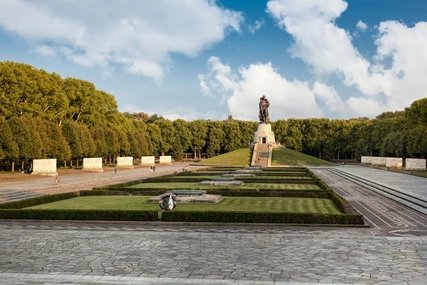
Even more monumental than the equestrian statues are the two Soviet memorials to the fallen soldiers of the Red Army. One can be found in Treptower Park, which invites you to explore its vast grounds. The other is located on the Straße des 17. Juni, near the Brandenburg Gate, oddly enough in the western part of the city. This mystery is explained by the fact that the Soviet forces erected the Soviet memorial at Tiergarten in the period before the city was divided into four occupation zones.
But the more recent history of divided Berlin has also left its mark. In protest against the construction of the Wall, young artists from Europe, Israel and Japan created some 20 sculptures for the 1961-1963 Symposium of European Sculptors, which have since grown into the greenery of the Tiergarten. Parts of the Wall itself are now anchored as monuments in the city and mark its path, for example as rusting steel stelae at the Berlin Wall Memorial or colourfully painted at the East Side Gallery.
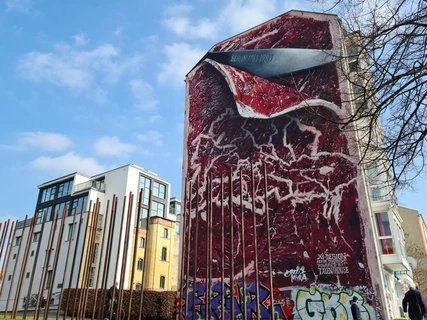
The division of the city, as well as its reunification, are still the subject of numerous works of art in public space. Examples are the Monument to Freedom and Unity which is still under construction and is being built in Berlin's Neue Mitte, the light installation "Rock, Paper, Scissors" at the Oberbaumbrücke, or the mural Steakart. This photo-realistic mural shows an incision into a raw steak whose streaks of fat trace the outline of the unified Berlin.
Façades and walls as witnesses of history

Although many walls and façades were destroyed during the Second World War, you will still find highlights when walking through Berlin: lavish stucco from the Wilhelminian period (Kronprinzenpalais), playful Art Nouveau elements (Amstel House), the simple elegance of Berlin Modernism, and of course, time and again, contemporary art on the building – sometimes also on the building fence like the current project by Hans Haak, who has been kicking off the Kunst am Bauzaun (Art on the Building Fence) project for the Museum des 20. Jahrhunderts (Museum of the 20th century) since May 2021 with his lettering "Wir (alle) sind das Volk" ("We (all) are the people") in twelve languages. Over the next few years, various artists will make their mark here for an open, culturally diverse and tolerant Berlin.
From the Kulturforum to Potsdamer Platz: Contemporary art in public space

If you walk from the Kulturforum towards Potsdamer Platz, you will see Olafur Eliasson's Windspiegelwand (Wind-mirror wall) glittering on the façade of the GIZ building on Reichpietschufer. Depending on the wind and weather, the small mirrors reflect clouds, sky and trees in the surrounding area, a poetic complement to the urban landscape. Not far away on Potsdamer Straße are the blue and red Boxers by Pop Art artist Keith Haring and in the same artificially created water biotope the steel object "Galileo" by US sculptor Mark di Suvero.
At the Kulturforum, Richard Serra's Berlin Curves blend perfectly into the curved architecture of Hans Scharoun's Berlin Philharmonic concert hall. The space between the two massive steel slabs can be walked on and its threatening narrowness contrasts with the wide forecourt of the concert hall. Somewhat closer to the Tiergarten, the artwork "Gegenüber" (Opposite) with its transparent blue glass wall is a memorial to the victims of the Nazi's involuntary euthanasia murders.
Memorials and Monuments

Today, memorials and monuments are important and impressive elements of Berlin's cityscape. Peter Eisenmann's field of stelae, the Memorial to the Murdered Jews of Europe, is probably the most central memorial. But traces can be found everywhere in the city; the Places of Remembrance in the Bavarian Quarter display the Nazi decrees for the disenfranchisement of the Jews on 80 signs; in front of house entrances, concrete cubes with brass plates known as Stolpersteine ("stumbling stones") commemorate Jewish citizens who suffered injustice. The "Voids," or empty spaces, which architect Daniel Libeskind has incorporated behind the titanium and zinc-clad façade of the Jewish Museum, also illustrate the fates interrupted by violence and deportation.
Courageous people and dissenters that still move Berlin
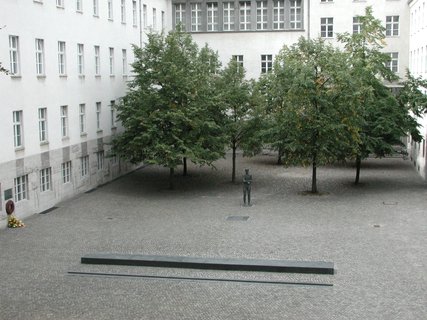
The courageous people who stood up against the abuses have also been commemorated. One example is the Georg Elser Memorial at Wilhelmstraße 90, erected in 2011 to mark the 72nd anniversary of the failed attempt on Hitler's life. Or the handcuffed youth that is the focal point of the German Resistance Memorial Center's courtyard of honour, which was designed by Erich Reusch as a memorial to July 20, 1944 in the backyard of Stauffenbergstraße 13-14.
With quotations formed of brass letters at Rosa-Luxemburg-Platz, conceptual artist Hans Haacke draws attention to the words of Rosa Luxemburg, the representative of the workers' movement who was murdered in Berlin in 1919. And a monument is also dedicated to Marx and Engels, the two philosophical pioneers of Marxism, in Berlin's Mitte near the Spree River.
Prominently placed: Haus der Kulturen der Welt and Government District

Another exciting place to discover art is on the Spree behind the Haus der Kulturen der Welt, one of many Berlin buildings designed by architect Werner Düttmann. In the water basin in front of the building, Henry Moore's bronze "Butterfly" is a fitting counterpart to the curved architecture of the Pregnant Oyster, as Berliners call the HKW. If you walk around the building to the Spree, you can discover other art objects on a stroll through the Government District, such as the two curved steel elements that interlock like two hands. The sculpture by Eduardo Chillida, prominently placed in front of the Federal Chancellery (Bundeskanzleramt), is a symbol of German reunification.
Tip: The architect Werner Düttmann, who played a major role in shaping Berlin, would have turned 100 this year. As part of its current exhibition, the Brücke Museum is presenting Düttmann's works on an interactive map, where you can view his architecture and learn background information about it.

In addition to the Haus der Kulturen der Welt, Düttmann's buildings include the Palais am Funkturm, the St. Agnes Kirche | König Galerie, the Akademie der Künste in the Hansaviertel, and the cafeteria of Berlin's Technical University. By the way, a visit to the TU is also worthwhile because of the sculpture garden hidden here. Around 80 works of art and monuments can be seen, including August Stüler's pair of Doric columns, sculptures by Werner von Siemens and Franz Reuleaux as well as Hans Rucker's pyramid, an enchanted, quiet place for students.
Sculptures and fountains as meeting places
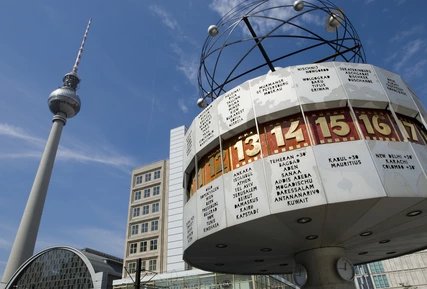
In fact, many of the sculptures and public artworks are popular meeting places for Berliners today. First and foremost, of course, the World Clock at Alexanderplatz. In summer, families with children seek refreshment at the Neptune Fountain near the TV Tower or at the Fairy Tale Fountain in Volkspark Friedrichshain. Many of the fountains have been given humorous nicknames, such as Joachim Schmettau's Globe Fountain on Breitscheidplatz, which Berliners simply call Wasserklops (water meatball).
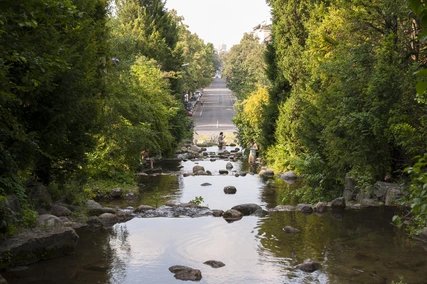
A must-see is the waterfall in Viktoriapark, at the foot of which is "the rare catch" by Ernst Herter: the bronze sculpture of a fisherman who has caught a mermaid in his net. At the top of Kreuzberg is the monument donated by Frederick William III to commemorate those who fell in the wars of liberation against Napoleon. Enjoy the view over Berlin from the steps – from the park's green treetops to Potsdamer Platz and the cathedral domes at Gendarmenmarkt.


